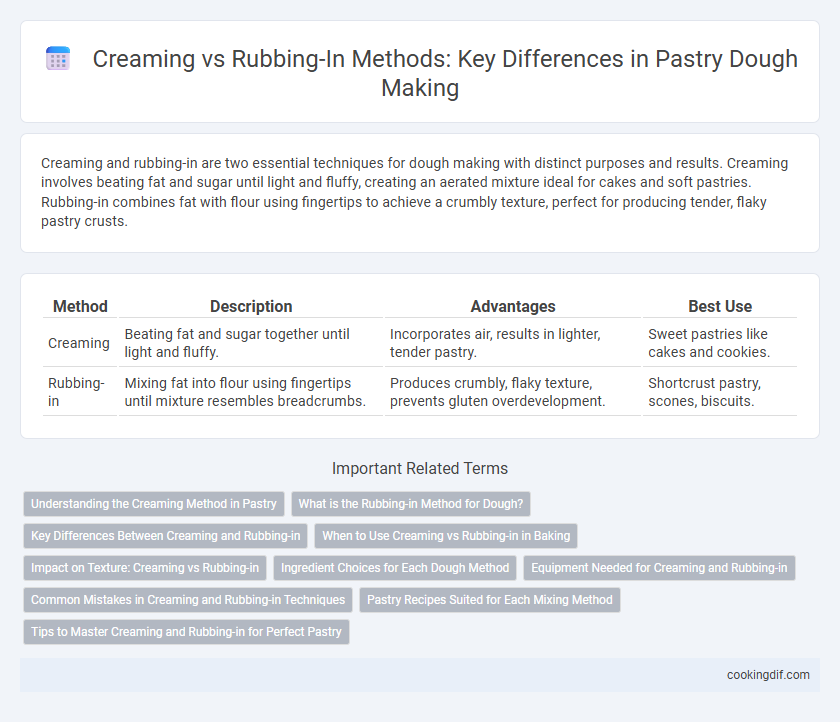Creaming and rubbing-in are two essential techniques for dough making with distinct purposes and results. Creaming involves beating fat and sugar until light and fluffy, creating an aerated mixture ideal for cakes and soft pastries. Rubbing-in combines fat with flour using fingertips to achieve a crumbly texture, perfect for producing tender, flaky pastry crusts.
Table of Comparison
| Method | Description | Advantages | Best Use |
|---|---|---|---|
| Creaming | Beating fat and sugar together until light and fluffy. | Incorporates air, results in lighter, tender pastry. | Sweet pastries like cakes and cookies. |
| Rubbing-in | Mixing fat into flour using fingertips until mixture resembles breadcrumbs. | Produces crumbly, flaky texture, prevents gluten overdevelopment. | Shortcrust pastry, scones, biscuits. |
Understanding the Creaming Method in Pastry
The creaming method in pastry involves beating fat, usually butter, with sugar until light and fluffy, creating air pockets that help leaven the dough and ensure a tender crumb. This technique differs from rubbing-in, where fat is cut into flour to produce a crumbly texture, emphasizing flakiness rather than softness. Mastery of creaming enhances texture and volume in cakes and pastries by promoting proper aeration and emulsification.
What is the Rubbing-in Method for Dough?
The rubbing-in method for dough making involves combining fat and flour by physically rubbing the ingredients together using fingertips until the mixture resembles fine breadcrumbs. This technique creates a crumbly texture ideal for pastry types like shortcrust, ensuring a tender and flaky crust by evenly distributing fat throughout the flour. Rubbing-in limits gluten development, resulting in a delicate crumb structure crucial for light, melt-in-the-mouth pastries.
Key Differences Between Creaming and Rubbing-in
Creaming involves beating butter and sugar together to incorporate air, resulting in a light and fluffy dough ideal for cakes and some pastries, while rubbing-in entails combining fat and flour by hand until coarse crumbs form, producing a tender and crumbly texture suitable for shortcrust and biscuit doughs. The creaming method relies on mechanical aeration for rise and softness, whereas rubbing-in controls fat distribution to prevent gluten development and maintain a crumbly consistency. Understanding these techniques is crucial for achieving the desired texture and structure in various pastry recipes.
When to Use Creaming vs Rubbing-in in Baking
Creaming is best used when making rich, tender cakes or cookies that require aeration, as it involves beating fat and sugar together to incorporate air for a lighter texture. Rubbing-in is preferred for pastry doughs and scones where a crumbly, flaky texture is desired; this method involves cutting cold fat into flour to create small fat pieces that melt during baking, forming layers. Choosing between creaming and rubbing-in depends on whether the recipe calls for a soft, airy crumb or a crumbly, flaky consistency.
Impact on Texture: Creaming vs Rubbing-in
Creaming incorporates air into the dough, resulting in a lighter, fluffier texture ideal for cakes and soft pastries. Rubbing-in involves blending fat into flour until it resembles breadcrumbs, producing a crumbly, tender texture perfect for shortcrust pastry. The choice between creaming and rubbing-in directly impacts the pastry's final crumb and mouthfeel, determining whether it is airy or crisp.
Ingredient Choices for Each Dough Method
Creaming method relies heavily on using softened butter and sugar, allowing air to be incorporated for a lighter, more tender dough ideal for cakes and soft pastries. Rubbing-in method involves cold butter cut into flour, creating a crumbly texture that limits gluten development, perfect for shortcrust and crumbly pastry doughs. Ingredient temperatures and fat types critically influence texture outcomes, with creaming favoring room-temperature fats and rubbing-in depending on chilled fats to achieve the desired flakiness.
Equipment Needed for Creaming and Rubbing-in
Creaming requires a stand mixer or hand mixer fitted with a paddle attachment to incorporate air efficiently into butter and sugar, producing a light and fluffy texture. Rubbing-in relies on minimal equipment, typically just mixing bowls and fingertips or a pastry cutter to combine fat and flour manually until the mixture resembles coarse crumbs. Using the right tools ensures proper texture development crucial for the dough's final consistency and flakiness.
Common Mistakes in Creaming and Rubbing-in Techniques
Common mistakes in creaming include overbeating, which incorporates too much air and leads to a crumbly texture, and using cold butter, preventing proper aeration. In rubbing-in, uneven distribution of fat causes inconsistent dough texture, while working the mixture too long activates gluten, resulting in toughness. Accurate temperature control and timing are essential to achieve the ideal delicate crumb or flaky pastry structure.
Pastry Recipes Suited for Each Mixing Method
Creaming is ideal for rich, buttery pastries like pound cakes and shortbread where incorporating air creates a light texture, while rubbing-in suits flaky pastries such as scones and pie crusts by distributing fat evenly to form crumbly layers. In creaming, butter and sugar are beaten until pale and fluffy, enhancing volume and tenderness. The rubbing-in method involves cutting cold fat into flour, preserving fat's solidity to produce crisp, tender dough perfect for pastries requiring a delicate, crumbly structure.
Tips to Master Creaming and Rubbing-in for Perfect Pastry
Mastering creaming involves beating butter and sugar until light and fluffy, which incorporates air to create a tender, airy pastry texture ideal for cakes and certain cookies. For rubbing-in, the technique requires gently mixing cold butter into flour using fingertips until the mixture resembles breadcrumbs, crucial for achieving flaky, crumbly pastries like shortcrust. To perfect both methods, ensure butter is at the right temperature--soft for creaming and cold for rubbing-in--and avoid overworking the dough to maintain the desired pastry structure.
Creaming vs Rubbing-in for dough making Infographic

 cookingdif.com
cookingdif.com